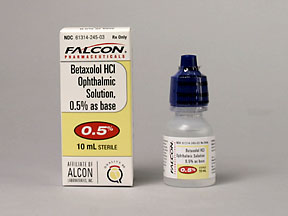
Betaxolol Coupons & Savings Card – Discount Prices from $38.02
Generic for: Betoptic-s
My prescription
Edit
10ML of 0.5%, Betaxolol (1 Bottle)
Select pharmacy

CVS
$73.51
COUPON PRICE
Walgreens
$38.02
COUPON PRICE
Walmart
$92.14
COUPON PRICE
Albertsons
$105.00
COUPON PRICEFree Betaxolol Savings Card

Walgreens
$38.02
Show this coupon to your pharmacist
ID
LHET286154
PCN
GDC
BIN
015995
GRP
GDRX
This coupon is not insurance
Related beta blockers prescriptions
More prescriptions for hypertension
Related beta blockers prescriptions
More prescriptions for hypertension
Price history for Betoptic-s (brand) & Betaxolol (generic)
1 Bottle, 10ML of 0.5%
Average retail price for Betoptic-s
Average retail price for Betaxolol
Average SaveHealth price for Betaxolol
Our price history data is based on aggregated prescription data collected from participating pharmacies in America. Our prescription data updates daily to reflect the latest price changes. If you notice a missing data point, it means there wasn't sufficient data available to generate a monetary value for that date.
We analyzed Betaxolol prices for (10ML of 0.5%, 1 Bottle) over the last 12 months. The average retail price was $330.19, while the average price using the SaveHealth discount card was $96.09. That's a savings of approximately 70.90% when using our Betaxolol coupon.
Compared to the generic version, Betoptic-s had an average price of $387.98 over the same time period. With the SaveHealth savings card, Betaxolol is 75.23% cheaper on average than Betoptic-s.
*Retail prices are based on pharmacy claims data, and may not be accurate when we don't have enough claims.
Betaxolol dosage forms
Dosage Quantity Price from Per unit 10ML of 0.5% 1 Bottle $73.51 $73.51 10ML of 0.5% 2 Bottles $129.02 $64.51 10ML of 0.5% 3 Bottles $184.53 $61.51
| Dosage | Quantity | Price from | Per unit |
|---|---|---|---|
| 10ML of 0.5% | 1 Bottle | $73.51 | $73.51 |
| 10ML of 0.5% | 2 Bottles | $129.02 | $64.51 |
| 10ML of 0.5% | 3 Bottles | $184.53 | $61.51 |
Betaxolol Warnings
The medication betaxolol (Betoptic-S) comes with important safety warnings that require careful attention. Please review the following information and discuss any concerns with your healthcare provider:
Diabetes Risk: Betaxolol can obscure symptoms of low blood sugar in individuals with diabetes, such as sweating and dizziness. Although only small amounts of this medication are typically absorbed into the bloodstream, it's advisable for diabetic patients to monitor their blood sugar levels more frequently while using this eye drop.
Thyroid Concerns: For those with an overactive thyroid, beta blockers like betaxolol can mask signs of hyperthyroidism, including a rapid heart rate. It's crucial to inform your optometrist or ophthalmologist about any thyroid issues before starting treatment.
Myasthenia Gravis: Betaxolol may exacerbate muscle weakness in patients with myasthenia gravis. If symptoms worsen, contact your healthcare provider promptly.
Breathing Problems: Individuals with lung conditions such as asthma or COPD should generally avoid using beta blockers like betaxolol, as they may cause narrowing of the airways. Ensure your healthcare team is aware of any past or present lung issues to determine if this medication is suitable for you.
Heart Conditions: If you have a history of heart problems like heart failure or heart block, betaxolol might affect your heart rate and blood pressure. Report any symptoms like swelling in the feet or ankles, irregular heartbeat, or shortness of breath to your healthcare provider.
Contraindications: Betaxolol should not be used in the following situations due to potential serious health risks:
- Sinus bradycardia (slow heart rate)
- Second- or third-degree heart block
- Heart failure
- Cardiogenic shock
Always consult with your healthcare provider to ensure this medication is safe for you, especially if any of these conditions apply.
Betaxolol Side Effects
Common side effects:
- Temporary stinging or discomfort in the eyes
- Watery eyes
- Feelings of dryness or itchiness
- Red eyes
- Blurred vision
- Feeling as if something is in your eye
Less common but important to monitor:
- Crusty lashes
- Changes in vision
- Increased sensitivity to light
Serious side effects:
- Eye pain
- Eye swelling
- Eye discharge
- Significant changes in vision
- Increased sensitivity to light
- Trouble breathing
- Sudden weight gain
- Chest pain
- Signs of heart failure like fatigue and swelling in the extremities
- Allergic reactions (rash, swelling of the face or throat, and difficulty breathing)
Betaxolol Interactions
Interactions with high risk of serious adverse effects and should be avoided:
- Albuterol
- Ceritinib
- Crizotinib
- Disopyramide
- Dronedarone
- Fenoldopam
- Fingolimod
- Formoterol
- Indacaterol
- Iohexol
- Lacosamide
- Levalbuterol
- Olodaterol
- Ponesimod
- Rivastigmine
- Salmeterol
- Siponimod
- Terbutaline
- Vilanterol
Interactions with moderate risk that may require dose adjustment, closer monitoring, or timing changes:
- Aceclofenac
- Acemetacin
- Amtolmetin Guacil
- Aspirin
- Bromfenac
- Bufexamac
- Celecoxib
- Choline Salicylate
- Clonixin
- Dexibuprofen
- Dexketoprofen
- Diclofenac
- Diflunisal
- Dipyrone
- Droxicam
- Etodolac
- Etofenamate
- Etoricoxib
- Felbinac
- Fenoprofen
- Fepradinol
- Feprazone
- Floctafenine
- Flufenamic Acid
- Flurbiprofen
- Ibuprofen
- Indomethacin
- Ketoprofen
- Ketorolac
- Lornoxicam
- Loxoprofen
- Lumiracoxib
- Meclofenamate
- Mefenamic Acid
- Meloxicam
- Morniflumate
- Nabumetone
- Naproxen
- Nepafenac
- Niflumic Acid
- Nimesulide
- Nimesulide Beta Cyclodextrin
- Oxaprozin
- Oxyphenbutazone
- Parecoxib
- Phenylbutazone
- Piketoprofen
- Piroxicam
- Pranoprofen
- Proglumetacin
- Propyphenazone
- Proquazone
- Rofecoxib
- Salicylic Acid
- Salsalate
- Sodium Salicylate
- St John's Wort
- Sulindac
- Tenoxicam
- Tiaprofenic Acid
- Tolfenamic Acid
- Tolmetin
- Valdecoxib
- Clonidine
- Propranolol
- Diltiazem
- Epinephrine
